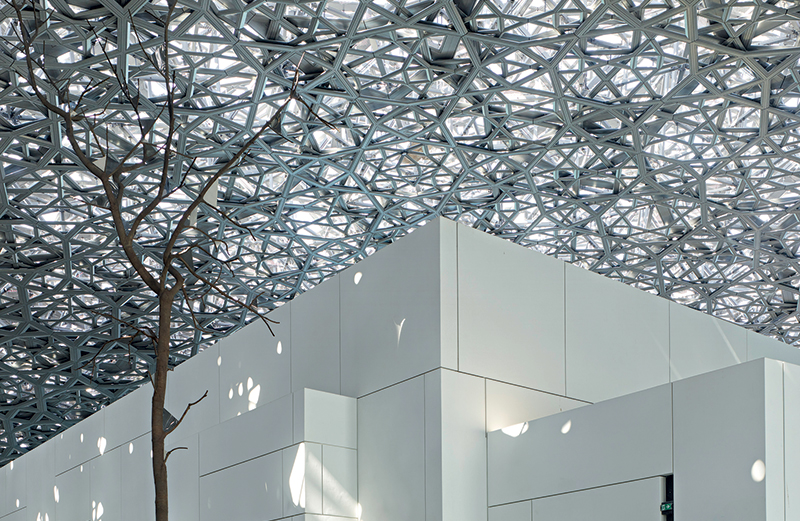Back | Blog posts overview
Louvre Abu Dhabi: A rain of light
12/08/2019
In the Louvre Abu Dabi, stainless steel not only protects precious artwork, but becomes art itself. The museum's breath-taking roof contains molybdenum to withstand one of the world's most corrosive environments. Inside, rays of sunlight dance across surfaces, creating a spectacle unlike any other.

© Photography Roland Halbe – Louvre Abu Dhabi – Architect Jean Nouvel
Where the desert meets the sea in Abu Dhabi, United Arab Emirates, a massive dome of stainless steel and aluminum 'stars' seems to levitate above water. But award-winning architect Jean Nouvel's design is no desert mirage. The stainless steel capped structure contains the new Louvre Abu Dhabi, a 'museum city' of 55 individual buildings, housing priceless artwork. Its design is a work of art itself, as brilliant as the pieces it houses. The museum's many stainless steel features, therefore, help to guarantee the longevity of the complex as a world-class tourist destination.
Sunlight enters the dome through a 'nebula of stars' weighing over 7,500 tonnes – as much as the Eiffel Tower. The roof is composed of 7,850 star-shaped elements superimposed over eight layers.
The stainless steel clad outer layers are separated from the aluminum inner layers by a five-meter high standalone steel structure. In total, the layers contain nearly 460,000 geometrically distinct intersections, linked by over 410,000 connection points. In addition to their differing shapes, the stars' angular arrangement varies from one layer to the next, which complicates the passage of light.
The engineers and the architect used stainless steel for the four upper layers of the dome, which are the most exposed to the climate, but also the most visible. The 4,481 stars of the upper layers were all clad on their upper face with 0.8-mm thick sheets made of duplex stainless steel. These sheets were first welded to each other, then fastened to the aluminum substructure through neoprene-insulated joints to avoid any galvanic corrosion of the aluminum by the stainless steel. To completely separate the two metals, the underside of the stainless steel sheets are clad with an anti-corrosion protective polyethylene film.
The Louvre Abu Dhabi inhabits one of the most corrosive environments in the world; an island exposed to desert heat and high humidity, surrounded by salty ocean spray. To resist this extreme environment, 3% molybdenum- containing type 2205 duplex stainless steel was used. Thanks to its higher molybdenum content, this stainless steel is significantly more corrosion-resistant than the 2% molybdenum-containing Type 316 austenitic stainless steel that is often used in less aggressive coastal applications. The matte 2E surface finish avoids creating excessive glare that could be blinding in the sun. Additionally, the stainless steel reflects the tints of the changing colours during the course of the day, and contributes to the festival of lights produced by the Louvre. Elsewhere in the museum, grating, walkways, and meshing are also made of 2205 duplex stainless steel. In all, 300 tonnes of this material have been used in the construction.
Stainless steel rebar was used to reinforce the 4,500 leak tight concrete piles drilled to nearly 15 meters below sea level that support the entire platform of the museum. The same rebar was also used in the 280 submerged columns, the concrete cut-off walls, and in a tailor- made 'protective wall' that safeguards the museum against any threat from the sea such as storms or collisions with ships. The alloy selected for these applications was 2304 duplex stainless steel, with 0.3% molybdenum. Combined with the ultra-high-performance concrete, this alloy offers both a guarantee against corrosion and a high ductility.
Read more here.
Back | Blog posts overview

